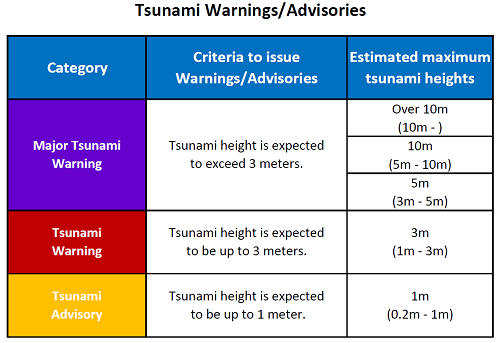Disaster Preparation
- Prepare for a disaster
- In case of a fire
- In case of an earthquake
- In case of tsunami
- In case of floods
- J-Alert System
Prepare for a disaster
- Do you plan how to place furniture?: In preparation for an earthquake, consider that "furniture always falls", and take measures to prevent it from falling.
- Is the stockpile of food and beverages sufficient?: Stockpile drinking water and food in case of disruption of lifelines such as electricity, gas, and water.
Drinking water: For 3 days (3 liters per person per day in general)
Emergency food: For 3 days (alpha rice, biscuits, chocolate bar, dry bread, etc.)
Also toilet paper, cassette stove, flashlight, etc. - Is your emergency carry-out bag ready?: Pack the things you should take out in case of emergency in advance.
- Do you know how to report on your safety?: After a disaster occurs, a safety confirmation email will be sent from the university or the safety information system "ANPIC". Please make sure to register in advance.
- Do you know the evacuation site and evacuation route?: Check the evacuation site and evacuation route in advance from the homepage of the local government.
- Do you have an access to disaster prevention information?: Use Niigata Prefecture Disaster Prevention Navi(Japanese only) and Niigata City Crisis Management and Disaster Prevention Bureau's Twitter (Japanese only).
<For your reference>
-Niigata Prefecture Disaster Preparedness Guide
-Preparing for Disaster (Niigata city page)
In case of a fire

In case of an earthquake
In case of tsunami
In case of floods
"Warning Level" and "Evacuation Information" will be released by the government through TV, radio, area mail, the Internet, disaster prevention radio,and public relations vehicles of the Disaster Prevention Bureau.
*You can find further information in "Campus Life Start Guide" (Japanese only) that is distributed to first-year students.
J-Alert System
The J-Alert system is a nationwide warning system which allows the Japanese government to instantly inform its residents across the country of various imminent threats, including ballistic missiles, earthquakes and tsunami. The system sends out emergency emails to the mobile phones in targeted area with a notification sound.
If you receive a warning message, especially regarding ballistic missiles, please follow the instructions on the website below and take actions to protect yourself.
Cabinet Secretariat: Actions in case of missiles flying to Japan



